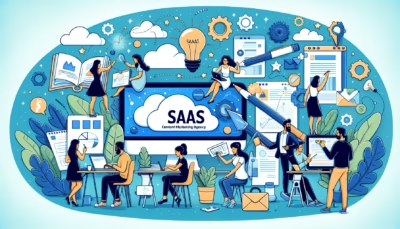Understanding SaaS Metrics
Want to up your SaaS mojo? Let’s talk numbers — the ones that make a real difference. Whether you’re knee-deep in marketing, creating killer content, or kicking off a startup, getting these key points down sets you on a path of your own.
Key Metrics Overview
Imagine your SaaS business with its finger on the pulse of growth, loyal customers, and finance sanity. Sounds good, right? Keeping tabs on specific numbers helps you make smart moves and sharpen your game. Shout out to Built In and HubSpot for spilling the beans on the five must-watch metrics:
Customer Churn Rate: Got customers slipping through your fingers? This figure tells you how many are bailing on you over time. It’s like a health checkup for keeping folks on board. For some guidance, check out what we’ve learned about keeping churn down in your SaaS gig.
Activation Rate: Are folks getting what they came for with your product? A solid activation rate shows that users are clicking with your vibe and sticking around after the intro.
Customer Lifetime Value (CLV): Picture the lifetime value of each customer — you want to know how much green they bring from the start to end of their journey with you. This helps with vibe-checking your spending and snagging new clients.
Burn Rate: This one’s for the newbies — how fast is your cash evaporating? Knowing this helps you make sure you’re not out of gas when you need more gears. Dig into our advice on finding and finetuning your customer costs right here.
LTV to CAC Ratio: Fancy stuff! Compare what a loyal customer makes you with what it cost to win them over. Higher numbers mean you’ve got a winning strategy. Aiming for a 3:1 score is golden. Get the scoop on using SaaS numbers in marketing plans.
| Metric | What it Tells You |
|---|---|
| Customer Churn Rate | Keeps tabs on who stays and who goes |
| Activation Rate | Tracks how users are clicking and connecting |
| Customer Lifetime Value (CLV) | Projects revenue per customer |
| Burn Rate | Keeps the cash flow on point |
| LTV to CAC Ratio | Sums up cost-effectiveness of customer deals |
Importance of SaaS Metrics
So, why bother with these numbers? They each give out nuggets of truth about your biz’s hustle and, when you piece ’em together, you get the total picture.
Customer Churn Rate is your eagle eye on scaling up. Know when folks engage, back off, or drift away. Constant churn tells you something’s off — maybe a glitch or maybe you’re not speaking their language.
Activation Rate gives you a front-row view of what it takes for users to see your value. Understanding this lets you adjust their ride with you, shooting up how many stick around.
Customer Lifetime Value (CLV) is all about long game vibes. It lets you know which customers are worth chasing hard, so up your spend where it counts and watch that growth spurt.
Burn Rate is your radar for dodging financial crashes. Especially when you’re starting out, knowing your spending speed lets you map out how far those coins will take you.
LTV to CAC Ratio takes the guesswork out of whether newcomers earn their keep. A good ratio is a badge that shows you’re smart with how you’re using cash to get cash. Check out our section on strong growth practices over at b2b SaaS growth marketing.
With these metrics in hand, you’re not just in the game; you’re leading it, making the street-wise decisions that keep the wind in your sails and the profits rolling in.
Customer-Related Metrics
In the realm of Software as a Service (SaaS), keeping an eye on customer-related metrics is like having a treasure map. They guide you to understanding what customers want and how to keep them around. I’m gonna talk you through three biggies: Customer Churn Rate, Activation Rate, and Customer Lifetime Value (CLV).
Customer Churn Rate
So, let’s chat about Churn Rate. This number tells you how many folks are heading out the door over a set time. It’s a bit like losing socks in the laundry—you need to know why it’s happening! Understanding churn is key to figuring out what’s not working and where your business might need some TLC (Built In).
| Metric | Description | Importance |
|---|---|---|
| Customer Churn Rate | The percentage of customers who take a hike in a given period. | Shows where customers might be unhappy |
Get a clue on why they’re leaving—maybe they’re not gelling with certain features or finding another path more appealing. If you want to dig into the nitty-gritty, you can read our full take on understanding and reducing churn rate in your SaaS business.
Activation Rate
Moving to Activation Rate: think of this as the “Aha!” moment for users. It’s about how many folks are really getting what your product does and using it that way. If this rate’s low, it might mean there’s a speed bump when users are trying to get started (Built In).
| Metric | Description | Importance |
|---|---|---|
| Activation Rate | Percent of users stepping into the light with your product’s value. | Pinpoints and smooths out onboarding hiccups |
A high Activation Rate means folks are happy and sticking around. For tips on knocking those onboarding blues out of the park, check out creating a seamless saas onboarding experience that reduces churn.
Customer Lifetime Value (CLV)
Customer Lifetime Value (aka CLV) is like peeking into a crystal ball to see how much a customer’s worth over time. Knowing this helps decide how much you should invest in keeping them sweet (Built In, HubSpot).
| Metric | Description | Importance |
|---|---|---|
| Customer Lifetime Value (CLV) | The cash a customer brings in during the whole time they hang around. | Forecasts profits and shapes spending decisions |
Here’s how you crack the CLV code:
- Customer Lifetime Rate (CLR): How long they tend to stick.
- Average Revenue Per Account (ARPA): How much dough each one brings in.
- CLV Formula: ( \text{CLV} = \text{CLR} \times \text{ARPA} )
Knowing CLV helps shift gears on how you handle customer relations—making sure everyone gets the royal treatment. For some killer strategies on this, take a peek at how to use saas metrics to make data-driven marketing decisions.
Keeping tabs on these metrics keeps your SaaS biz zipping along. Keep checking in on them and tweak your strategy to keep customers buzzing and your business booming.
For more nuggets of wisdom, have a look-see at proven saas customer retention strategies to keep your users engaged and paying and the ultimate guide to building a winning saas marketing strategy in 2025.
Financial Metrics
Keeping an eye on financial numbers is like keeping your health in check, essential for SaaS folks, ensuring the bucks keep flowing and aren’t squandered like confetti at a parade. I’m gonna chat about two biggies: Burn Rate Calculation and the Lifetime Value (LTV) to Customer Acquisition Cost (CAC) Ratio.
Burn Rate Calculation
Burn rate is all about how fast a SaaS startup uses its stash of cash, like watching how quickly ice cream melts on a hot day. It’s super necessary to know this number so you don’t find yourself scraping the money jar’s bottom before turning a profit. Investors and founders are all about figuring out how long the cash will last before they need to start job hunting (Built In).
You’ll want to know about these types of burn rates:
- Gross Burn Rate: This is the big picture cost per month, like rent, snacks, and fancy coffee.
- Net Burn Rate: This is the real talk—what’s left after counting your dollars in and dollars out.
| Metric | Formula | Example Calculation |
|---|---|---|
| Gross Burn Rate | Total Operating Expenses | $100,000/month |
| Net Burn Rate | (Total Revenues – Total Expenses) | -$50,000/month |
Suppose your SaaS business is throwing down $100,000 a month to keep the lights on but pulls in $50,000. That means you’re burning $50,000 a month. Knowing this stuff helps you pencil out your survival kit and make sure you’re not running on empty. If you’re just getting your feet wet, peek at effective SaaS lead generation tactics to fatten up your wallet.
Lifetime Value (LTV) to Customer Acquisition Cost (CAC) Ratio
LTV to CAC is the secret sauce in checking if wrangling new customers is a winning bet. It’s a question of whether what you receive from a customer knocks out what you laid out to reel them in. Aiming for a 3:1 ratio is where SaaS businesses wanna be (Built In).
Customer Acquisition Cost (CAC) Calculation:
| Metric | Formula | Example Calculation |
|---|---|---|
| CAC | (Total Sales and Marketing Spend) / (Number of New Customers) | $5,000 / 50 customers = $100/customer |
Customer Lifetime Value (LTV) Calculation:
| Metric | Formula | Example Calculation |
|---|---|---|
| LTV | (Average Revenue per Customer) * (Average Customer Lifespan) | $100/month * 24 months = $2,400 |
LTV to CAC Ratio:
| Metric | Formula | Example Calculation |
|---|---|---|
| LTV to CAC Ratio | LTV / CAC | $2,400 / $100 = 24 |
Here, an LTV to CAC ratio hitting 24 tells you you’re slaying it out there. Keeping this magic number tamed and productive is the ticket to growth and dollar signs. If fine-tuning’s on your agenda, see calculating your SaaS customer acquisition cost (CAC) and how to optimize it.
Keeping tabs on these money moves offers sweet, sweet wisdom about your SaaS venture’s strength and the big picture. For a bit more, browse our stuff on saas marketing strategies and b2b saas marketing.
Customer Satisfaction Metrics
Net Promoter Score (NPS) Overview
Alright, let’s chat about Net Promoter Score or as we like to call it, NPS. It’s sort of like the MVP of checking out how loyal your customers are, especially if you’re kicking it in the SaaS arena. Imagine asking folks, “How likely are you to recommend this to your buddy?” on a scale from zero to ten. Simple, right? Well, that’s where the magic happens, ’cause these scores give us a peek into how folks feel about us, how we’re growing, and who’s actually buying this stuff (Survicate).
So, here’s the deal: NPS splits people into three packs:
- Promoters (9-10): These are the ride-or-die folks. They’re all about us and wouldn’t mind putting in a good word.
- Passives (7-8): They’re chill but not super hyped. They could easily switch sides if someone else waved something shiny at them.
- Detractors (0-6): Not happy campers. You might hear them sharing their not-so-great thoughts around, which is why they need extra TLC.
Anything above zero for an NPS score? You’re already on the plus side with more fans than critics. In SaaS land, scores from 0 to 30? Pretty solid. A score between 30 to 70? Now we’re talking! Over 70, and you’ve got yourself some hardcore customer love. Back in ’21, the average NPS for SaaS buddies was 32. Not bad, huh? (Survicate).
| NPS Category | Who Are They? | Score Range |
|---|---|---|
| Promoters | Your biggest fans | 9-10 |
| Passives | Meh, they’re alright | 7-8 |
| Detractors | Not spreading the love | 0-6 |
Want the deep dive into SaaS metrics? Well, we’ve got the ultimate smarts right here in our guide on data-driven marketing.
Utilizing NPS for Business Growth
Got your NPS? Awesome, now let’s really get things moving. This feedback can work wonders to keep customers happy and boost growth. Here’s how to do it:
Spot the Hits and Misses: Running NPS checks is like hunting for gold when figuring out what tickles your customers’ fancy and what just ain’t cutting it. Add a couple of open-ended questions to the mix, and you’ll get some genuine, real-life tips on what’s working. You’ll know exactly where to sprinkle glitter and where to rethink your strategy (Survicate).
Foresee Billing Jitters: With NPS, you get a glimpse of who’s loyal and who’s about to pack their bags. Knowing this means you’re all set to jump in and save the day before the goodbyes happen. More secrets to keeping loyal customers here on reducing churn.
Amp Up Your Fan Bragging: Hype up your loyal fans as they’ll do the talking for you, bringing in fresh faces just because they love you. Give them a nudge with a thank you or a little something extra, and watch them rave about you everywhere!
Patch Up the Rough Spots: Taking time to listen and talk to those unhappy folks? They might just surprise you by signing back up with a smile. Sometimes, turning a frown upside down can make all the difference in building long-term happiness with your crowd.
For some A+ actionables on using that NPS gold, explore our email marketing funnel tips that keep everyone in the loop.
- Score Bigger Wins with Upsells and Cross-sells: Armed with your NPS insights, it’s easier to spot who’s ready for more and who’d love a side order with their usual. Align offers with what they’re raving—or grumbling—about, and watch as they happily upgrade their game.
Plop these practices into your business hustle, and watch SaaS take growth and loyalty to a level worth buzzing about! If you’re on the horizon for more smart marketing moves, why not dive into our kickbutt marketing strategy guide?
Advanced Metrics Analysis
Alright folks, let’s chat about how to really get in there and figure out if your SaaS company is rocking it or if it’s more like, uh oh, what’s happening? We’re gonna chew the fat on two biggies here: revenue churn and how long you gotta wait to get back that sweet, sweet customer acquisition cash. So hold onto your hats.
Revenue Churn Evaluation
Okay, picture this: revenue churn is like a wake-up call for how losing customers messes up your dollars (HubSpot). It’s like when you’ve got a leaky bucket and your cash is the water – not great! This little number lets you see how bad the leak is and what type of customers are slipping away.
Here’s the lowdown on the math: you grab the cash (monthly recurring revenue, MRR, that is) that left the building and divide it by what you started with. Here’s what it looks like all fancy:
[ \text{Revenue Churn} = \frac{\text{Churned MRR}}{\text{Total MRR at the beginning of the month}} ]
Keeping this number on the low is the name of the game. Focus on keeping those customers smiling, making sure your product is right up their alley, and ramping up your customer success squads. Nail this, and you’ll figure out where the customer love is lacking and patch it up pronto.
| What It’s About | What It Means |
|---|---|
| Monthly Revenue Churn | What’s leaving your cashbox every month thanks to folks saying, “Bye, Felicia,” to your service. |
Need more on plugging the leak? Check out our article on understanding and reducing churn rate in your SaaS business.
Months to Recover CAC Calculation
Now, let’s talk about how long your wallet cries before it goes back to “happy dance” mode. Months to Recover CAC, or “how many months until we’re not in the red for getting this customer?” uses this nifty formula (HubSpot):
[ \text{Months to Recover CAC} = \frac{\text{Customer Acquisition Cost (CAC)}}{\text{Monthly Recurring Revenue (MRR) per Customer}} ]
Shorter is better here, folks. It means you’re making green on those new pals faster. This lets you pile up greenbacks quicker to go find even more newbies to add to your gaggle.
| What It’s About | What It Means |
|---|---|
| Months to Recover CAC | How much time till that new customer pays back what you forked over to win ‘em over. |
Getting this CAC time down is goldmine stuff for your bank account. This way, you can throw that cash right back into things that matter: marketing razzle-dazzle, sales charm, and making your product even cooler.
Take a look-see at our tips on calculating your SaaS Customer Acquisition Cost (CAC) and how to make it work for you.
By owning these metrics, SaaS pros out there – whether you’re scheming marketers, creative content champs, or those brave enough to start a startup – you can make moves that keep your biz on the right track. Check out our stash of goodies like B2B SaaS content marketing, SaaS marketing tools, and more to really grab the power of SaaS metrics by the horns.





